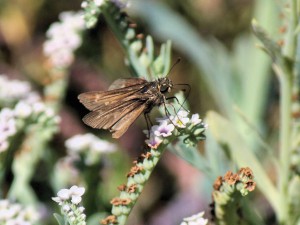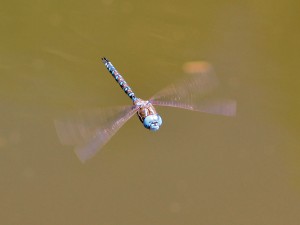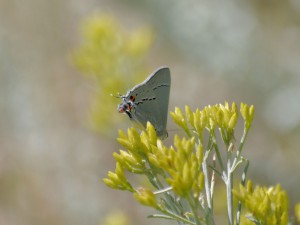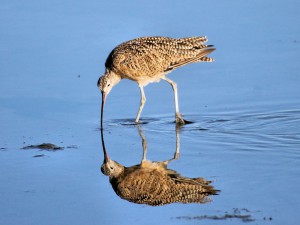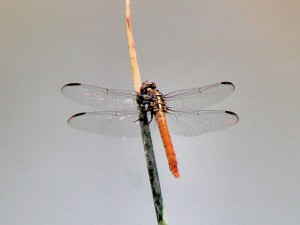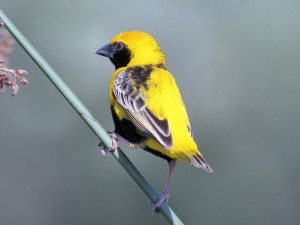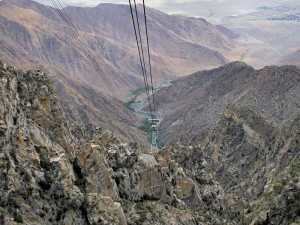The Variegated Meadowhawk (Sympetrum corruptum) is a large North American dragonfly. Typically, Variegated Meadowhawks range across Canada from British Columbia to Ontario, and most of the U.S. from California to Florida. Averaging 1.5 – 2 inches in length with a wingspan of 2.5 – 3 inches, scientists classify Variegated Meadowhawks as medium-sized dragonflies. These highly migratory dragonflies sometimes turn up on Caribbean Islands and even in eastern Asia. Typically, they often cruise over dry land as often as in the vicinity of ponds and streams. Variegated Meadowhawks are “sally hunters”. That means they launch on feeding sorties, and return to the same spot, much like a Western Wood-Pewee. Thus, sally-hunting makes these dragonflies much easier to photograph than many subjects. And well worth it. Continue reading
Author Archives:
Wandering Skippers
The Wandering Skipper (Panoquina errans) is a small butterfly that lives only in coastal saltmarsh. They range from Santa Barbara County, California south to northern coastal Baja and the Sea of Cortez. Their range is a narrow band close to the ocean. This is because this butterfly’s larval food plant, saltgrass, only lives in coastal salt marsh. Wandering Skippers fly in late summer and fall, usually in two broods.
Finding Wandering Skipper
As it happens, one of the largest Wandering Skipper colonies is right here in Orange County at Upper Newport Bay. References said that they were present in the highest density in the vicinity of Big Canyon. So we started to look for them in late July. They weren’t easy to find! It wasn’t until August that we found a single individual, nectaring on the tiny purple flowers of European Seaheath (Frankenia pulverulenta). We went back several weeks later and found a fair few more of them, again feeding on the Seaheath. Continue reading
Blue-eyed Darners
Blue-eyed Darners (Rhionaeschna multicolor) are common throughout California. This dragonfly is a mosaic darner. This mosaic darner family contains at least 10 species, all of relatively similar size and coloration. Hence, mosaic darners are often quite hard to tell apart. The family gets its name from the beautiful pattern of coloration on the abdominal segments. The broad distribution of Blue-eyed Darners extends from central Canada south, across most of the United States and all the way down to Panama in Central America. Furthermore, the completely blue eyes and absence of a black line dividing the face distinguish Blue-eyed Darner from all other members of the family. They also differ in the shape of the abdominal appendages. Continue reading
Hairstreak Butterflies
Hairstreaks high-jacked us on a recent birding trip to Big Bear in the San Bernardino Mountains! Hairstreak butterflies are found in a variety of habitats here in southern California.
Gray Hairstreaks
On this trip, we found two species: the common Gray Hairstreak (Strymon melinus) and the rarer Great Purple Hairstreak (Atlides halesus). Gray Hairstreaks are one of the most widespread butterflies in North America, native to all lower 48 states, southern Canada and northern Mexico. Like most hairstreaks, the Gray tends to fold its wings when landing. Recognize this butterfly by the light gray coloration, prominent orange rectangle on the underside of the hind wing, and a line of dark spots on both fore and hind wings.
Little hair-like extensions of the hind wing rear margins form the “hairs” that give these butterflies their name. On Gray Hairstreaks, the hair is fairly prominent; it is much less so on some other members of the family, like the Elfins or the Hedgerow Hairstreak. Continue reading
Long-billed Curlew
The Long-billed Curlew (Numenius americanus) bears several distinctions among North American shorebirds. In addition to being the largest common sandpiper on the continent, it is also the one with the largest bill. The bill size of the Long-billed Curlew is quite variable, with females generally having notably longer bills than males. The two genders have different shaped bills as well. Male Long-billed Curlew bills show nearly continuous curvature along its length. But the female’s overall flatter bill terminates in a sharply hooked tip. Note how this bird’s lower mandible is distinctly shorter than the upper, falling short of the often sharply curved tip.
Finding Long-billed Curlew in SoCal
Long-billed Curlews are common wintering birds in southern California, gathering in huge numbers on the agricultural fields of Imperial County, and in smaller numbers at Bolsa Chica Preserve and Upper Newport Bay here in Orange County. A certain small number of Long-billed Curlews do not migrate north to their breeding grounds each year, meaning there are some individuals present year round at locations like Bolsa Chica. Continue reading
Salton Sea Dragonflies
We took a trip to look for Salton Sea dragonflies and birds during the first week of August. Stop and think about that: the Salton Sea in August! Are we nuts?! Probably, but there are some things you can only find there in the summer, and the Salton Sea seems to always be good for odes (dragonflies and damselflies).
Mindful of the fact that it can easily top out over 120°F there in the summer, we took a lot of sunscreen and water, started well before dawn, and planned on leaving early. By 7:30 it was unpleasantly hot; by 8:30 it was sweltering. But we were finding birds and bugs so it was all good. We had the company of our good friend, Bob Miller, a local birding and odes expert who lives in Brawley, and who knows where to find everything worth seeing in terms of local wildlife at the Salton Sea. Continue reading
Yellow-crowned Bishops
A male Yellow-crowned Bishop (Euplectes afer) recently made news in Orange County. Part of what makes this unusual is that Yellow-crowned Bishop isn’t a wild bird. It undoubtedly is a released or escaped cage bird. Originally, Yellow-crowned Bishops come from Africa, and inhabit nearly every sub-Saharan country. So what’s all the fuss about? Well, for starters, he’s a cracking bird!
Where to Find Him
Moreover, this bird is just fun to watch! Present in San Diego Creek just upstream of Audubon House at San Joaquin Wildlife Sanctuary, this Yellow-crowned Bishop is very territorial. He perches high in clusters of sedge and aggressively chases virtually anything that comes near – Scaly-breasted Munias, Common Yellowthroats, House Finches… whatever! He doesn’t just chase them though; he puts on a show! First he puffs his feathers up and half opens his wings, about doubling in size. Then he launches at the intruders with rapid shallow wing beats looking like an angry little quail in hot pursuit. All the time, he utters a high-pitched, metallic, plinking call. His turf protected, he returns to his previous perch high in the sedge.
Almost any exotic escaped cage bird can become established in the southern United States. People who said the Pin-tailed Whydah would never become established in California are looking a bit foolish right now! You just never know. Continue reading
Palm Springs Aerial Tram
During a recent visit from family, we took the famous Palm Springs Aerial Tram up to Mountain Station (see photo of Mountain Station here), the entrance to Mt. San Jacinto State Park. The ride is quite dramatic. It rises 6000 feet from a dry desert bottom to 8516 feet at Mountain Station, in under 15 minutes. The Swiss-made aerial tram cars have a rotating floor so that passengers get the full panorama during their climb without jostling for position. Once you arrive at Mountain Station, you have a choice of activities. You can visit the gift shop, catch a snack or a meal at the Peaks Restaurant. Alternatively, exit into Long Valley and take some of the hiking trails in the state park. We ended up doing all three of those. Continue reading
Summer Pelagic Trip from Dana Point
The Summer Pelagic trip out of Dana Point sponsored by Sea & Sage Audubon was last Saturday, 12-JUL-14. On Saturday, a light wind raised a bit of chop that made it unpleasant for some trip participants, even on the 70-foot R/V Sea Explorer, and it certainly made photography a bit more challenging! Getting a good, steady view of these birds can be difficult at the best of times, and an additional source of motion doesn’t help.
Conditions in the Santa Barbara Channel seldom get anywhere near as rough as those out in the open ocean. In fact, our relatively calm waters are part of what makes these quarterly Sea & Sage Pelagic trips with the boat from the Dana Point Ocean Institute so appealing. Another advantage to these trips is the vast experience of the Ocean Institute personnel, particularly Captain Mike Bursk, whose vast knowledge of all the ocean wildlife adds greatly to the experience. Continue reading
OC NABA Butterfly Counts, 2014
The Orange County chapter of the North American Butterfly Association (OC NABA) held its annual butterfly counts this weekend. Counts took place in Thomas Riley Regional Park and O’Neill Regional Park. It was my privilege to participate in the Riley count and to lead the O’Neill count. We had a pretty much ideal day for them, warm and clear without being beastly hot, though a little more moisture to bring on a bloom of more flowers would have been helpful.
As it was, the diversity of butterfly species was a bit on the low side, while the numbers of some species, notably Checkered Whites and Marine Blues were fairly impressive. We had 35 Marine Blues on the Holy Jim Canyon section of the O’Neill count alone, mostly clustering around wet mud puddles. They were difficult to count accurately since they were always moving, and you had to be careful that you didn’t miss something different hiding amongst them. We had a handful of duskywing butterflies, mostly Funereal Duskywings (photo). Many of these were freshly emergent, so the subtle markings in the upper wings and the white trailing edge of the hind wings were particularly bright and well-defined. Continue reading

